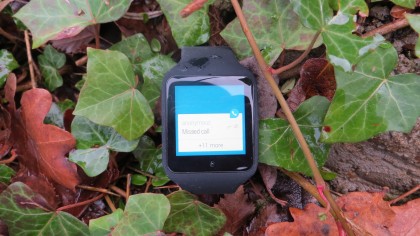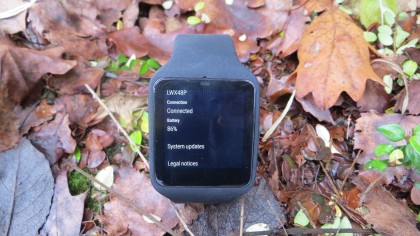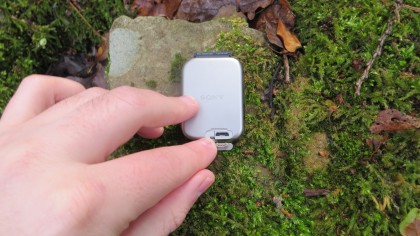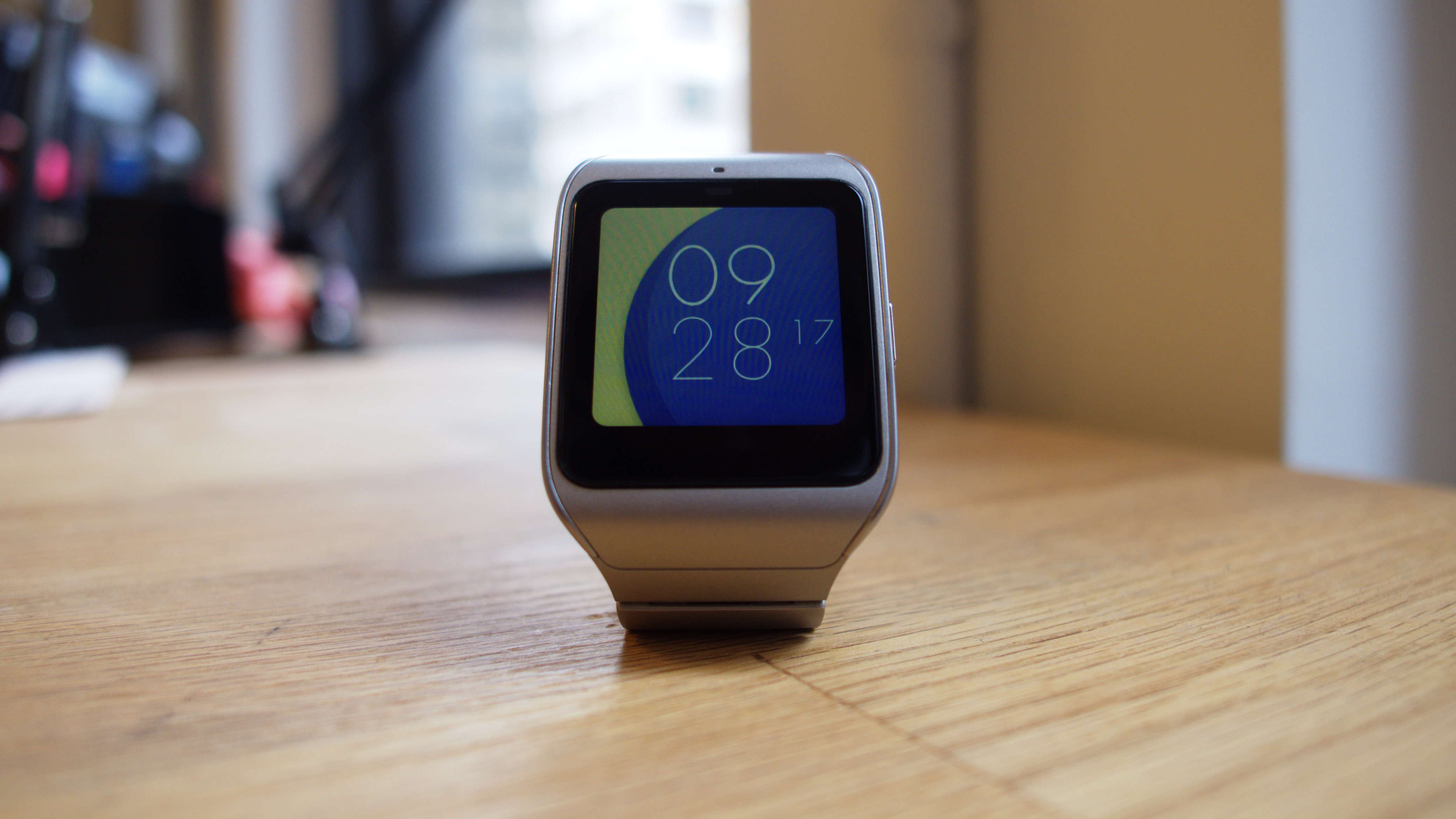Why you can trust TechRadar
Like most recent smartwatches the Sony SmartWatch 3 runs Android Wear and as this OS doesn't allow for much manufacturer added flair (aka bloat) if you've used one of these smartwatches, you've essentially used them all.
It's good then that Android Wear is quite an attractive and well thought-out system in its relative infancy, though there's always room for improvement.

The first screen you'll see on the watch is the actual clock face. This will dimly be shown at all times unless you un-tick the always-on option in settings. A single tap on the screen will light it up, or you can raise your wrist to achieve the same, while placing your palm over it or just waiting a few seconds will cause it to dim again.
A long press on it brings up a selection of alternate faces so you can customize it to your own taste. If you aren't finding something you like, the Google Play store has hundreds for you to peruse. Or you can check out our list of the best Android Wear watch faces.

Back on the main screen you can swipe up to scroll through information cards, showing traffic, weather and the like, much like Google Now does on a phone and swipe left across any of them to get more details and options or swipe right to clear them. If you want to recall them you have a brief opportunity to with a swipe down.
A swipe down from the clock face will show your remaining battery and allow you to mute the watch, then from there a swipe left will give you access to the settings screen and 'cinema mode', which ensures the screen stays off unless you press the power button. Handy in cinemas and anywhere else that needs to be dark.

Tapping the clock face or saying 'OK Google' will bring up a screen which allows you to give it voice commands, such as sending texts and making notes.
I found this mostly works quite well, even in fairly loud environments, though I did need to speak slower and more clearly than I would in normal conversation and in a lot of cases it took longer than just reaching for my phone would have.

If, instead of speaking, you swipe up from this voice screen you can get a list of possible commands you can give it, with a tap carrying that command out, or as close to as possible. For example tapping on 'take a note' will let it know that you want to take a note but you'll still have to speak the note, while tapping 'show me my steps' will do just that, with no speaking required.
If you scroll right to the bottom you'll find other options like the settings screen and the start menu.

The former lets you adjust the screen brightness, pair Bluetooth devices, turn on airplane mode, reset or restart the device, change the watch face, invert the colours, increase the text size or search for software updates, while the latter gives you a list of all compatible apps that you can launch from the watch.
It used to be that these screens were only accessible by digging this deep into Android Wear, but since the update to Android 5.0 the settings screen at least can be accessed by swiping down from the clock face and left a couple of times.
The update also made it so that screens you've recently accessed or actions you've recently carried out will sit at the top of the options list, giving you easier access to things you use regularly.
It's worth noting that while the Sony SmartWatch 3 has its own settings screen, certain settings are only accessible from within the Android Wear app on your phone, such as toggling whether you can tilt the watch to wake the screen. It seems odd and unnecessary to separate features like this, but it's not a big deal once you know where things are.
If you get a call, message or notification then that will pop up on the main screen of the watch and cause it to vibrate to alert you to it, at which point you can interact with it or clear it. If it's a call you can opt to answer or reject it, but if you choose to answer it still comes through on your phone (or a Bluetooth headset if you have one paired). There are no embarrassing wrist conversations here.

For the most part this all works pretty well and I found it genuinely useful being able to just glance at my wrist to see what an email said or what the notification I just got was rather than having to dig my phone out of my pocket, especially as in many cases it would be things that I'd just as soon ignore anyway.
It also had the advantage that I never missed a message or call, because while the vibration isn't all that strong it's a lot more noticeable against your wrist than it is from a bag or pocket. Its functionality is limited and as such it's not as exciting as some gadgets but it genuinely saved me time in my day and meant I wasn't as distracted by my phone.
It's not the most intuitive interface and the SmartWatch 3 doesn't do a brilliant job of explaining how everything works, but it's simple enough that it doesn't take too long to get to grips with.
Performance seems pretty good too. Occasionally the watch wouldn't register a tap and it can take a while to process voice commands, for example sending texts or opening apps on my phone.
There are times when it sits there long enough that I wish I'd just done something by hand, but when navigating the interface and scrolling through messages and alerts there's no noticeable slowdown at all. But that's no surprise given the 1.2GHz quad-core processor and 512MB of RAM that it's packing.
Battery life and connectivity
Battery life is an even bigger issue on smartwatches than it is on smartphones, as not only do some of them actually sport worse life than the average handset but people are likely to be less accepting of having to give their watch a regular juicing, when a normal watch needs charging precisely never.
The Sony SmartWatch 3 doesn't solve this problem but it's far from one of the worst offenders. It's got a 420mAh battery, which is big for a watch. The LG G Watch R for example is slightly smaller at 410mAh and the Moto 360 has a much smaller 320mAh battery, so that's a promising start. Sony reckons it can last for up to two days of use and I'd say that's just about right.

With what I'd think of as average mixed use it lasts around a day and a half. For example on one day I unplugged it at 8:30am when it was 100% charged and by roughly midnight it was down to 59% battery.
That was with it connected to my phone all day, the screen always on, regularly getting emails and notifications, many of which I read from my wrist and on a few occasions I used the voice controls as well as using it to control Spotify on my computer for a while.
So with light use it can just about stretch to two days, but I can't see it ever lasting longer than that and if you start using GPS that life begins to plummet. Still, that's up there with the best battery life of any smartwatch, other than the Pebble anyway, which is in a league of its own.

When it is time to charge it the Sony SmartWatch 3 does at least benefit from having a microUSB port, so there's no need for the proprietary chargers or docks that most smartwatches favour. That's handy as there's always likely to be a microUSB cable lying around and they're small enough that you could easily carry one with you if needed.
On the other hand that port does add a bit of bulk to the watch and it's not the easiest to access, so it would be nice if it supported wireless charging as well for when you just can't be bothered to pry open a flap and struggle to plug it in.

The Sony SmartWatch 3 is a better connected device than most wearables, as not only does it have the obligatory Bluetooth 4.0 along with common features like ambient light sensors, an accelerometer, a compass and a gyro, but also GPS and NFC.
I talk about GPS in the apps and fitness section and NFC isn't really supported by Android Wear yet, but it means that the SmartWatch 3 will be more future-proofed than wearables that don't have it.
James is a freelance phones, tablets and wearables writer and sub-editor at TechRadar. He has a love for everything ‘smart’, from watches to lights, and can often be found arguing with AI assistants or drowning in the latest apps. James also contributes to 3G.co.uk, 4G.co.uk and 5G.co.uk and has written for T3, Digital Camera World, Clarity Media and others, with work on the web, in print and on TV.
